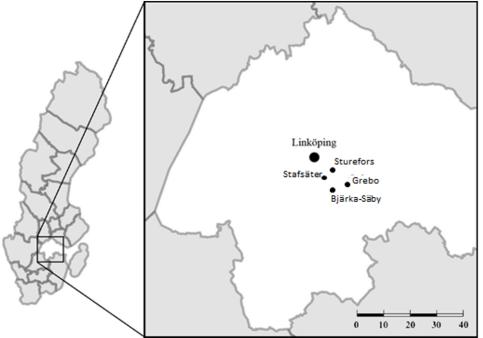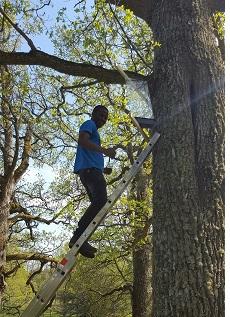Study area and study site.

This study was conducted in eight areas, situated 20-30 km south of Linköping city in southern Sweden, on the property of some large landowners in Bjärka Säby, Stavsätter, Hovetorp and Sturefors ). A good number of trees from the old study were identified in these areas. The landscape is known to have a considerably higher number of mature hollow oaks (mostly Quercus robur), some of the older oaks at the studied sites have been estimated to be around 400-600 years old. Other trees species found in the landscape are; ash (Fraxinus excelsior), aspen (Populus tremula), birch (Betula pendula), Norway spruce (Picea abies) and Pine trees (Pinus spp).
The studied trees & their surrounding
Canopy cover & Forest regrowth assessment
A total of 51 oak trees from the 1994 study were revisited and sampled for saproxylic beetles. Canopy Cover (CO) assessment was done using a simple three class categorisation assessment, the same as the one used in the 1994 study, where 0 - 24% meant CO = 0 totally open, 25 - 75% CO = 1 open with patches of closed sky and 75 - 100% CO = 2 less than 25% open sky. In assessing the Forest Regrowth, bushes or trees more than 4m in height, and were either within or at a distance of not more than 5m from the edges of the crown were considered as regrowth. Using the tree as a central reference point, 4 imaginal directional segments were created around the tree, were classification 4 meant = all directions(segments) around the tree were covered with regrowth of younger trees or larger bushes. The shadowing as a result of the bushes/trees on the main tree in any one segment needed to be more than ca 50% to be considered as classification 1 or 1 segment of regrowth.
Sampling methods

Saproxylic beetles were captured using a flight interception method (i.e. transparent Plexiglas 30*60cm also known as window traps), with an aluminium tray placed underneath. The aluminium tray was filled with propylene glycol and water mixture, in the ratio 1:1, for the purpose of preserving the trapped beetles and eliminating surface tension. The traps were placed in the beginning of May and emptied every third week starting from June 1st until August 25th, 2018. Sorting of samples and identification of species was done in the lab under a dissecting microscope The species identification was restricted to the beetle families identified in the 1994 study and the taxonomy used followed fauna europaea nomenclature. Captured species were further sorted according to ecological groups based on feedings habits at larval stage and families.
Statistics
The explanatory variables for the study were trunk circumference, canopy cover, forest regrowth, cavity entrance size, height from ground, while species number or species composition was the response variables.The correlation between explanatory variables revealed that canopy cover and forest regrowth were highly correlated, while trunk circumference and canopy cover had a low correlation value despite being statistically significant. Therefore, canopy cover and forest regrowth could not be used at the same time in the analysis to avoid collinearity. Ordination was used to show the relationship of species found and the sampled trees while at same time factoring in the measured explanatory variables. Detrended Correspondence Analysis (DCA) was used to analyse species data for both years in order to find the main gradient. Canonical Correspondence Analysis (CCA) was used to explain the species data for both years, using canopy cover, trunk circumference and cavity size as explanatory factors. Further, a generalised linear model was fitted to determine the association between canopy cover, trunk circumference and cavity size with species number.All statistical analysis was carried out in R software (R Core Team, 2018)..
Responsible for this page:
Director of undergraduate studies Biology
Last updated:
07/14/19
